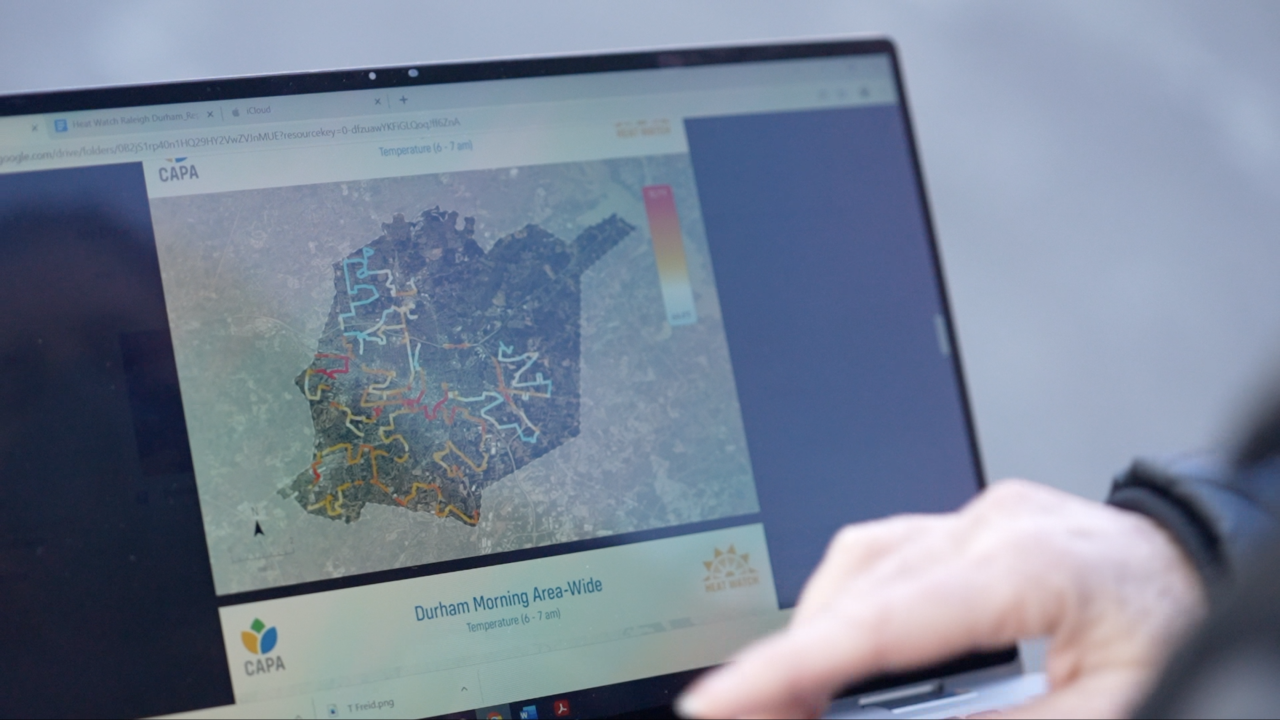Even in the middle of a North Carolina winter, Durham County sustainability manager Tobin Freid is thinking about the potential impacts of heat.
“One of the big impacts that we are seeing and expect to see more of is extreme heat events, so either very high temperatures or very prolonged times of high levels of heat,” Freid said.
“In an area like this, it could be up to 20 degrees hotter than an area a mile away that has more green space, more trees. So on hot days, it's even hotter in these areas,” she said, referring to urban areas filled with buildings, parking lots, and asphalt.
Durham and Raleigh, which are neighboring cities, are taking a closer look at urban heat islands.
“Green spaces stay a little bit cooler and places with a lot of pavement and buildings heat up a lot faster so we call these urban heat islands,” Kathie Dello, the state climatologist of North Carolina at NC State University, said.
“Things that are around those things like brick and asphalt and concrete are going to feel warmer, longer,” Freid said.
The question is, how much warmer?
Raleigh and Durham were one of almost a couple dozen regions to receive a grant in 2021 for the CAPA Heat Watch program, a national program looking at heat on a granular scale. The program is put on by a partnership between the National Integrated Heat Health Information System and CAPA Strategies.
“What we wanted to do is get the temperature reading of where humans kind of feel the heat on their skin and we wanted to do that at a very high resolution,” Vivek Shandas, an advisor with CAPA Strategies, said.
“In Raleigh-Durham’s case, we collected almost 100,000 measurements over one warm, kind of hot, day on July 23, 2021. So those 100,000 measurements, compare that to the single measurement you get for a whole city,” he said.
Over the summer, volunteers like Jenna Gant helped gather the data. Volunteers drove, biked, and walked with these sensors to collect information.
“You have the temperature sensor that you put on the window and then you roll up the window to kind of put it in place, and once it starts collecting data you have your route,” Gant said.
“It has sensors on there that map the heat and relative humidity every 15 seconds,” Freid explained. “Right after the campaign we packed up all the sensors and sent them back to NOAA to be analyzed. They extracted all of the data out of it.”
She received the results at the end of 2021. It’s an annual process that’s been happening for years. Cities such as San Diego, Detroit, and Miami have all applied, been accepted, and received a grant for the Heat Watch program in the past. They received the data back in the form of heat maps in return.
“We want to get these in front of planners, public health officials,” Shandas said.
Heat is the deadliest weather hazard in the U.S. It contributes to about 143 deaths a year, according to NOAA.
“Extreme heat poses a really big public health risk in both daytime heat and nighttime heat. And we know that where people live is not equitable, so a lot of lower-income people live in places without adequate shading and access to green space,” Dello said.
“We wanted to make sure we were covering particular neighborhoods that have histories of racism, that have pockets of poverty, as well as wealthier neighborhoods so that we can kind of compare impacts of heat in those different areas,” Freid said.
She said the city recognizes that historical and institutional racism has resulted in the effects of extreme heat affecting parts of the community more than others.
Freid said this data can help form better solutions from more trees to better cooling options in different neighborhoods, something they will engage with the community about moving forward.
“It’s not going to be something that's fixed tomorrow. This is something that's going to take a while to put these things in place,” she said.





